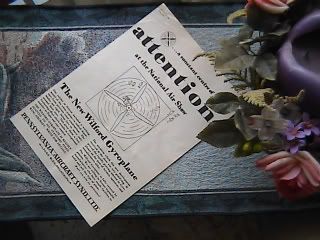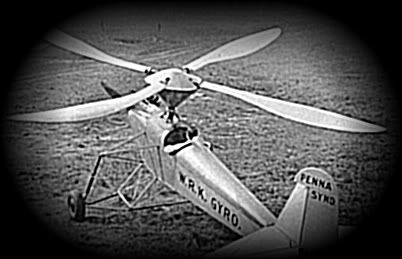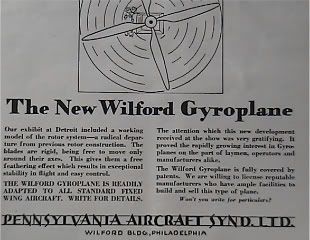|
Wilford WRK Gyro: The First Rotorcraft with Cyclic Pitch Control and Rigid Rotor System.
Unique to this rotorcraft was the preceding history with the complications of the rigid rotor system. The use of a rigid rotor was attempted very early in rotorcraft development and when these aircraft sat upon the confines of the ground most were able to achieve full rotor speed but when the aircraft started to lift off the ground the effects of dyssemetry of lift would cause the aircraft to roll and impact the ground. It was the advancement in rotor stability by Juan de la Cierva that would make rotary-wing flight practical. Cierva designed the fully articulated rotor, which relieved bending forces and allowed the blades to flap and (later) lead and lag in their position. Cierva’s designs however did not take full advantage of the rotating wing. Control of his autogiros was by conventional control surfaces already in existence on airplanes, rudder, aileron and elevator control.
The notable and historic achievement of the WRK Gyro was the practical application of cyclic pitch control. This advancement allowed the aviator to directly control the pitch direction of the rotor disc. This development would improve the agility of the aircraft and later be one of the required technologies needed for the development of a practical vertical lift aircraft, the helicopter.
The Start of Something SpecialWilford's first aircraft was built with partner Vincent Burnelli and entered for the Guggenheim Safe Airplane Contest in 1927. This aircraft was particularly designed for low-speed landing. Wilford left the United States in 1928 headed for Europe where he was able to secure the rotor design patent rights of German designers Walter Rieseler and Walter Kreiser
Walter Rieseler: 1890-1938Rieseler was born in Berlin, Germany in 1890 and developed a passion for aviation at a young age. Alongside his brother Walter founded an aircraft company in 1920 at Breslau. Rieseler and his friend Walter Kreiser continued to design and experiment with many facets of aviation and on January 24, 1926 the two were awarded a patent for an autogyro. It should be noted that this patent was issued two days prior to the patent issued to Cierva in England. The following year Rieseler and Kreiser built their first autogyro with financing coming from a banker in Hamburg. The Rieseler and Kreiser autogyro was of normal design for the period but they were attempting to directly control the rotor unlike what Cierva was attempting in England. Rieseler wanted to take full advantage of the four blades swinging overhead but after the first test, which showed strong oscillations for which they could not get under control. This design flaw was enough for the banker to back out of any future funding of the project. Rieseler’s work did not go unnoticed however and both Rieseler and Kreiser were persuaded by Professor Alexander Kleimin of the Guggenheim Institute at New York to come to the United States to continue their work. In 1930 the two aircraft designers left Germany to form a partnership with E. Burke Wilford in Pennsylvania. The new company being called the Pennsylvania Aircraft Syndicate or PAS. Work progressed well for the Syndicate and on August 5th of 1931 they rolled out their first autogyro for its first flight. F.P. Brown flew the single seat aircraft and following the successful first flight began a series of modifications to the design, which included replacing the engine with a more powerful type, they shortened the fuselage length and widened the wings. The modified ship was then christened the WRK Gyro with the initials of the Syndicate members.
In 1934, Rieseler decided to return to Germany and try and tackle the challenges presented with helicopter development. Walter Rieseler founded the Rieseler and Company in Berlin. Rieseler went on to design three different helicopters, two of which were flown and crashed. The final design the RIII, was not built as in January of 1938 at the young age of 47 Walter Rieseler passed away from a heart attack and the works of Rieseler fell into obscurity.
Making of A Legend:On February 27, 1929 Mr. William Devaney sold his “Twin Brook Farm” to E. Burke Wilford due to Mr. Devaney’s health. Wilford purchased the property for the purpose of designing and flight testing an aircraft he called the gyroplane. Wilford was one of several early rotorcraft pioneers testing the state-of-of-the-art in rotorcraft design just as were Cierva and Pitcairn. Naturally attempting to secure a place in the aviation industry and reap the financial rewards of their technological advances. In May of 1929, the farm was legally transferred in ownership from Wilford to the Philadelphia-Main Line Airport, Incorporated. Mr. Wilford was the president of this new corporation. Wilford began development of the property to suit his needs and began with modifying the barn into a workable hanger facility. The word PAOLI was displayed on the barn roof to identify the new airport. As this work was being carried out the gyroplane was being completed in New Jersey. December of 1930 the new aircraft was shipped to PAOLI to begin its taxi tests as “Configuration Number 1”. During the next several months Wilford’s engineers and mechanics produced a second aircraft, this second configuration being called the “WRK Gyroplane”. In August of 1931 Lt. Frank Brown took the controls for the first of nearly 200 flights in the “WRK”. This was the first successful flight of any rigid rotor design in the world. Wilford and his team would continue to fly his aircraft from PAOLI until 1932. In 1932, Wilford moved his team to a new site in Essington, Pennsylvania. The new location having formerly served as a seaplane base and World War I training center. Along with this new location came a new name for his organization and Wilford formed the Pennsylvania Aircraft Syndicate Ltd. It was at this new location where in 1934, configuration 3 suffered from a structural failure that killed the pilot. This tragic event moved Wilford to temporarily halt his gyroplane project.
Technical Advancements:
The cyclic control provides the pilot a means to tilt the rotor system to provide a direct means of flight control. By tilting the rotor system the gyroplane can be directed for ascending, descending, and banked flight. By directly controlling the rotating wing or rotor system, over conventional airplane flight controls, provides for more precise control and quicker response of input- in short, a more agile aircraft. The employment of the rigid rotor system has seen some of aviation’s most impressive helicopters, the Lynx, Cheyenne and Bo-105 as examples. The rigid rotor system is mechanically a rather simple arrangement but is extremely complex from a structural point of view. In a rigid rotor system the blades are not allowed to lead/lag or flap but can be feathered (through cyclic input). Due to this rigidity of the blades the operating loads must be absorbed in bending rather than through hinges and bearings. All flapping and lead/lag forces are absorbed quite simply by blade bending in the rigid rotor system.
Resources:The Illustrated Encyclopedia of Helicopters by Giorgio Apostolo, Copyright 1984 by Bonanza Books and distributed by Crown Publishers Inc.
Helicopters of the Third Reich by Steven Coates - 2002 Classic Publications Die deutsche Luftfahrt - Hubschrauber und Tragschrauber by Kyrill von Gersdorff & Kurt Knobling- 1985 Bernard & Graefe Verlag Hartmut Rieseler Dipl.Ing.Mschb. http://www.rieseler.de http://scale-autogiro.spaces.live.com/blog/cns!4A9F23F99E6A9956!783.entry P.Lambermont "Helicopters and Autogyros of the World", 1958 Rotorcraft Flying Handbook FAA-H-8083-21, U.S. Department of Transportation Aero Digest, April 1935 Aero Digest, February 1935 Aero Digest, February 1932 http://www.history.navy.mil/photos/ac-usn22/n-types/n2y.htm
Title: The aerodynamic analysis of the gyroplane rotating-wing system Author(s): Wheatley, John B Abstract: An aerodynamic analysis of the gyroplane rotating-wing system is presented herein. This system consists of a freely rotating rotor in which opposite blades are rigidly connected and allowed to rotate or feather freely about their span axis. Equations have been derived for the lift, the lift-drag ratio, the angle of attack, the feathering angles, and the rolling and pitching moments of a gyroplane rotor in terms of its basic parameters. Curves of lift-drag ratio against lift coefficient have been calculated for a typical case, showing the effect of varying the pitch angle, the solidarity, and the average blade-section drag coefficient. The analysis expresses satisfactorily the qualitative relations between the rotor characteristics and the rotor parameters. As disclosed by this investigation, the aerodynamic principles of the gyroplane are sound, and further research on this wing system is justified. NASA Center: Langley Research Center Publication Year: 1934 Document Source: CASI Online Source: View PDF File Document ID: 19930081495 Accession ID: 93R10785 Publication Information: Number of Pages = 30 Report Number: NACA-TN-492 Price Code: A03 Related Information: NACA Technical Note 492. Accessibility: Unclassified; No Copyright; Unlimited; Publicly available; Updated/Added to NTRS: 2006-11-06 http://ntrs.nasa.gov/archive/nasa/casi.ntrs.nasa.gov/19930081495_1993081495.pdf A HISTORY OF THE MAIN LINE AIRPORT PAOLI, PENNSYLVANIA Roger D. Thorne http://www.tehistory.org/hqda/pdf/v40/Volume40_N2_041.pdf Creation of the Philadelphia Main Line
|




